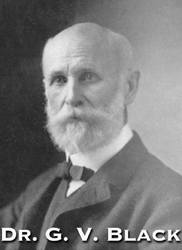|
Caustic chemicals, heat-and-friction producing drills that damage the delicate crystalline structure of a tooth, and questionable filling compounds which may damage a patient's immune system are still used. The filling technique of drilling a large opening in a tooth to wedge in a mixed-metal filling, developed by pioneering dentist Dr. G.V. Black over a century ago, is still taught in dental schools today. Many of today's American dental practitioners seem to be stuck in a rut of indifference to learning new things. They are satisfied with the things that they were taught in dental school, and the dental schools themselves, by and large, are stuck with the attitude of "that's the way we've always done it, and it works, so why change?" Imagine if other industries or professions had taken that attitude. We wouldn't have most of the modern conveniences that we enjoy and benefit from today--no computers, high-definition televisions, digital audio, cell phones, high-speed travel, the internet, satellite technology--none of these things existed a hundred years ago, yet they were developed by people working and researching in industry and technology, who were interested in improving and advancing their chosen fields for the benefit of society. And let's not forget the medical profession. Organ transplants, limb-reattachments, coronary bypass operations, MRI's, laproscopic surgery, sonograms, EKG's, EEG's did not exist a century ago, and yet now they are taken for granted as part of our culture's "medical menu." However, in America, dentistry's developments and improvements still plod along at a snail's pace, with most practitioners ignorant, uncaring, or both, about how the treatments they perform affect oral health and the health of the entire body. As an analogy, if today's railroad industry was run like American dentistry, trains would still be pulled by coal-smoke belching steam locomotives, their boilers insulated with asbestos and subject to occasional explosions. Freight trains would still be manned by six-person crews instead of just two, as they are today. Archaic signaling systems would make accidents far more prevalent. There would be no two-way satellite/radio communication systems or GPS to tell dispatchers where any train was at any given moment. Shippers would have a hard time pinpointing where their shipments were or what the arrival times would be. To be sure, that system worked a hundred years ago but it had its flaws. It was much more inefficient, non-cost-effective and dangerous than it is now. The freight-hauling railroads and their operating officials saw the need for change and improvements, and because of their continual efforts at modernization, upgrading, technical innovations, training and educating their employees, and streamlining their operations, they have been able to stay in business and keep making profits, even in a shaky economy. If dentistry had advanced and improved as much as the railroads have, it would be a whole new, almost unrecognizable profession from ten decades ago. Sadly, it hasn't done that. Laser Dental Centers of America realizes this and is trying to push the dental profession forward, kicking and screaming though it may be, into the 21st century. Modernization and streamlining is the key, as well as taking advantage of all the new and exciting developments in lasers and other treatment techniques, and training practitioners to use them correctly. By reducing treatments to several basic, standardized offerings with proven track records, that are healthier and less stressful alternatives for the patients, overhead and costs are reduced. Benefits to the patient as well as to the practitioner, are increased. Offering these services will introduce this new, patient-friendly and innovative type of dental treatment to more and more people, thus (hopefully) forcing the entire profession of dentistry to change its lackadaisical attitude towards progress. Laser Dental Centers of America, with nearly 15 years of experience, research, development, and thousands of satisfied patients behind it, is poised to do just that.
|
 (Dr. Black, who was revered in his time as a dental innovator, and who held an M.D. as well as a D.D.S. degree, would be shocked and appalled at the lack of progress his beloved profession has made in the span of a century. He was always looking for ways to improve the art and practice of dentistry, and he once made a statement that has become part of our own working philosophy: "The professional man has no right to be other than a continual student.")
(Dr. Black, who was revered in his time as a dental innovator, and who held an M.D. as well as a D.D.S. degree, would be shocked and appalled at the lack of progress his beloved profession has made in the span of a century. He was always looking for ways to improve the art and practice of dentistry, and he once made a statement that has become part of our own working philosophy: "The professional man has no right to be other than a continual student.")